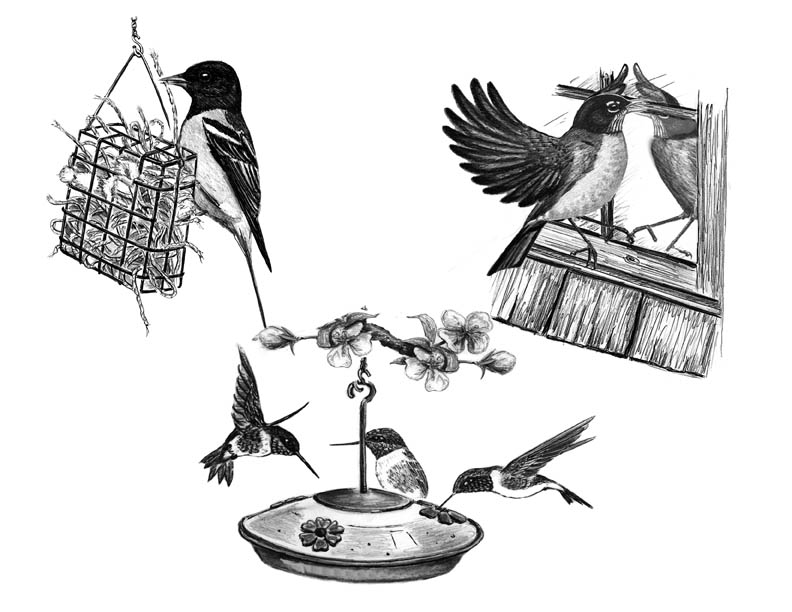
Dear Bird Folks,
We are getting lots of Baltimore Orioles eating from the oranges we have set out, but we’d like to have these pretty birds nest in the trees in our yard. Is there anything we can do to encourage them?
– Maura and Marie, Mt. Kisco, NY
Good idea, M&M,
Your question reminds me that it is now late spring and this is the time of year when we get a whole batch of predictable questions: questions about returning hummingbirds, piggish grackles and psycho birds attacking windows. If you don’t mind, M&M, I’d like to answer your question plus several other recurring questions in this one column. This will save me from answering these topics in the coming weeks. However, the answers will be different than usual. To save room, instead of my typical eloquent, Shakespearian answers, these responses will be dry, dull and short, as if John Kerry were answering them…except for the short part.
String. That’s what orioles use to build their nests. If you put out short (12”) pieces of string or even yarn, Mrs. Oriole will readily scoop them up and weave them into her hanging nest. A more organic alternative is horsetails. Each spring a nice guy from the nearby town of Brewster, who fixes violin bows for a living, drops off a bag of assorted used horsetail hair and the birds fight over them. Who knew?
While we are talking about orioles, in recent years more people have been offering them grape jelly instead of oranges. Orioles really seem to like jelly, but some professionals question if we are doing the birds more harm than good. Jelly has a super high concentration of sugar and perhaps that’s not a good thing. Also, due to poor feeder design many birds end up with sticky jelly coating their feathers. That’s a serious problem for the birds, not to mention silly looking. My advice is to offer oranges or sugar water (they make hummingbird-style feeders that accommodate orioles). If you use jelly, put out small amounts and use it sparingly. Enough said.
Our phone has already started ringing with the season’s most commonly asked question: What is the formula for hummingbird food? This year, just like last year, the mixture is four parts tap water to one part white, table sugar. Red food coloring is not recommended, nor is it needed, and neither is boiling. Some folks swear boiling is important, so boil away if it makes you happy, but I don’t think the birds care either way. The more important thing is to change your food every few days. If the birds discover a feeder that contains spoiled food they will leave and often don’t return, and no amount of boiling will bring them back.
Some people take their feeders down in May and put them away until fall. That’s fine, but they could be missing some of the most interesting birds of the year. Here on Cape Cod May’s migration often produces surprise visits from such colorful birds as Scarlet Tanagers, Rose-breasted Grosbeaks and Indigo Buntings. If you put your feeders away too early, all these gorgeous birds could end up at your neighbor’s yard. You don’t want that, do you?
If you believe what the calendar says, you’ll notice that May leads to June, and in June many of our backyard birds are busy taking care of their babies. Most newly hatched chicks are fed a steady supply of insects by their parents. The protein-packed insects are good for the young birds, but they’re not that great for me. Birdfeeders tend to be quiet during June, my seed sales drop off and customers complain, “Where are the birds?” Not to worry. Once the babies start flying they will return to the feeders and my seed sales will resume. I hope.
One bird that never seems to take a break from our feeders is the Common Grackle. Grackles are large dark birds that often feed in flocks. Because they are big birds, they have big appetites. Many folks aren’t thrilled when grackles take over their feeders. Grack-a-phobes have two options. One is to use safflower seed. Safflower seed is one of the grackles’ least favorite seeds and they often, but not always, leave it alone. The other option is a cage feeder. The ugly, but effective cages allow smaller birds to feed while excluding larger birds. There is one problem with the cage, however. It prohibits all large birds, including the beloved cardinals. As always, discrimination has a price.
One of the more interesting spring questions is when someone claims that birds are “trying to get into my bedroom.” In the spring birds try to drive away rivals, even if the rivals are their own reflections. Somehow, even with their keen vision, some birds aren’t able to tell another bird from their own reflection in a bedroom window. When this happens the angry bird jumps at the glass, over and over and over. Robins, cardinals, sparrows and even turkeys have been known to do this. The only way to stop the insanity is to cut off all reflections by blocking the window from the outside. Sometimes the obsessed bird goes away, but most of the time it just moves on to another window…that is hopefully in someone else’s bedroom.
Finally, back to you, Maura and Marie. As I said, orioles love string and yarn for their nests. If you don’t have any string or can’t afford yarn, try the organic option. Just grab some scissors and sneak up behind the nearest horse. But if you do that, just be careful where you poke the scissors.